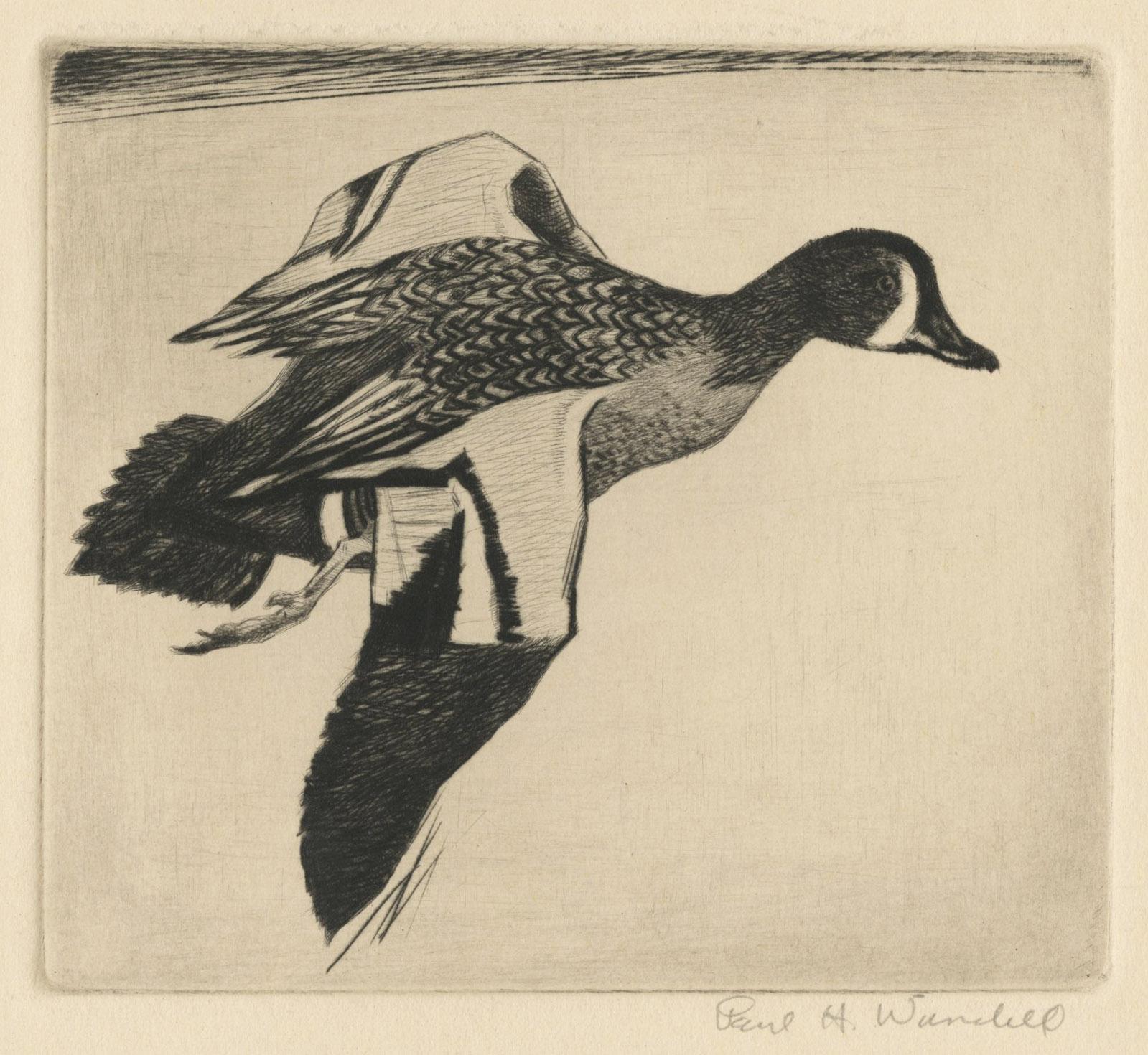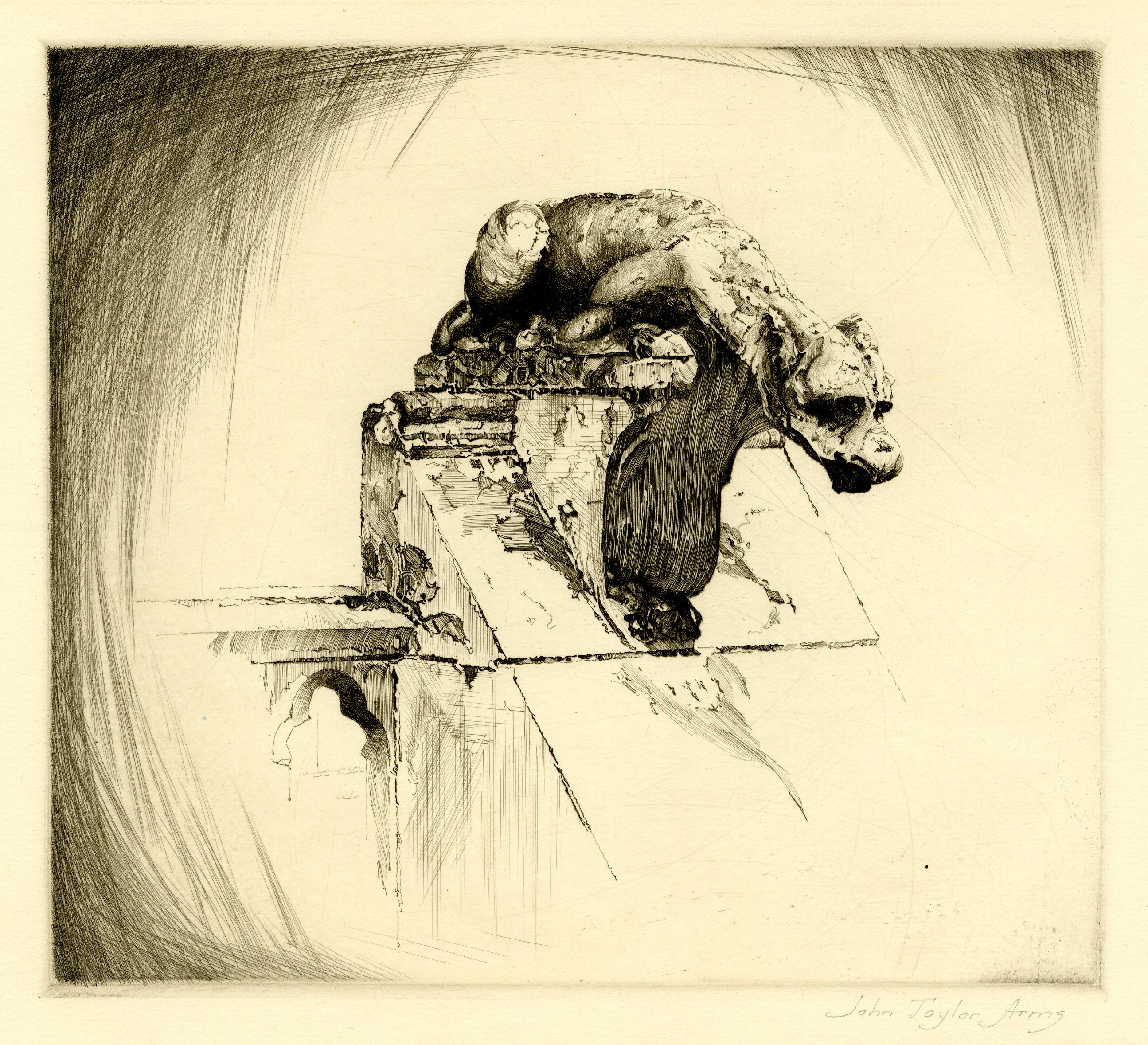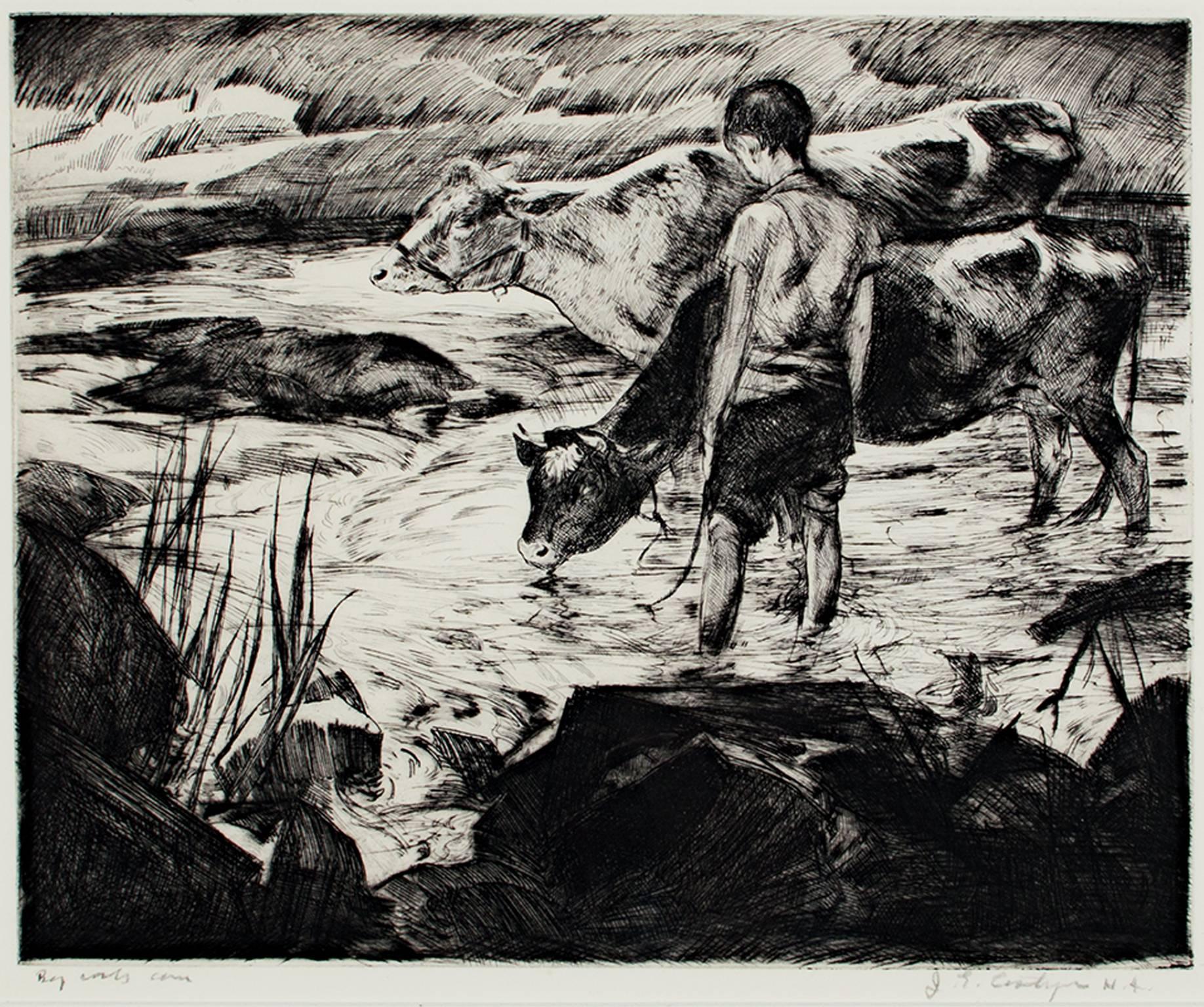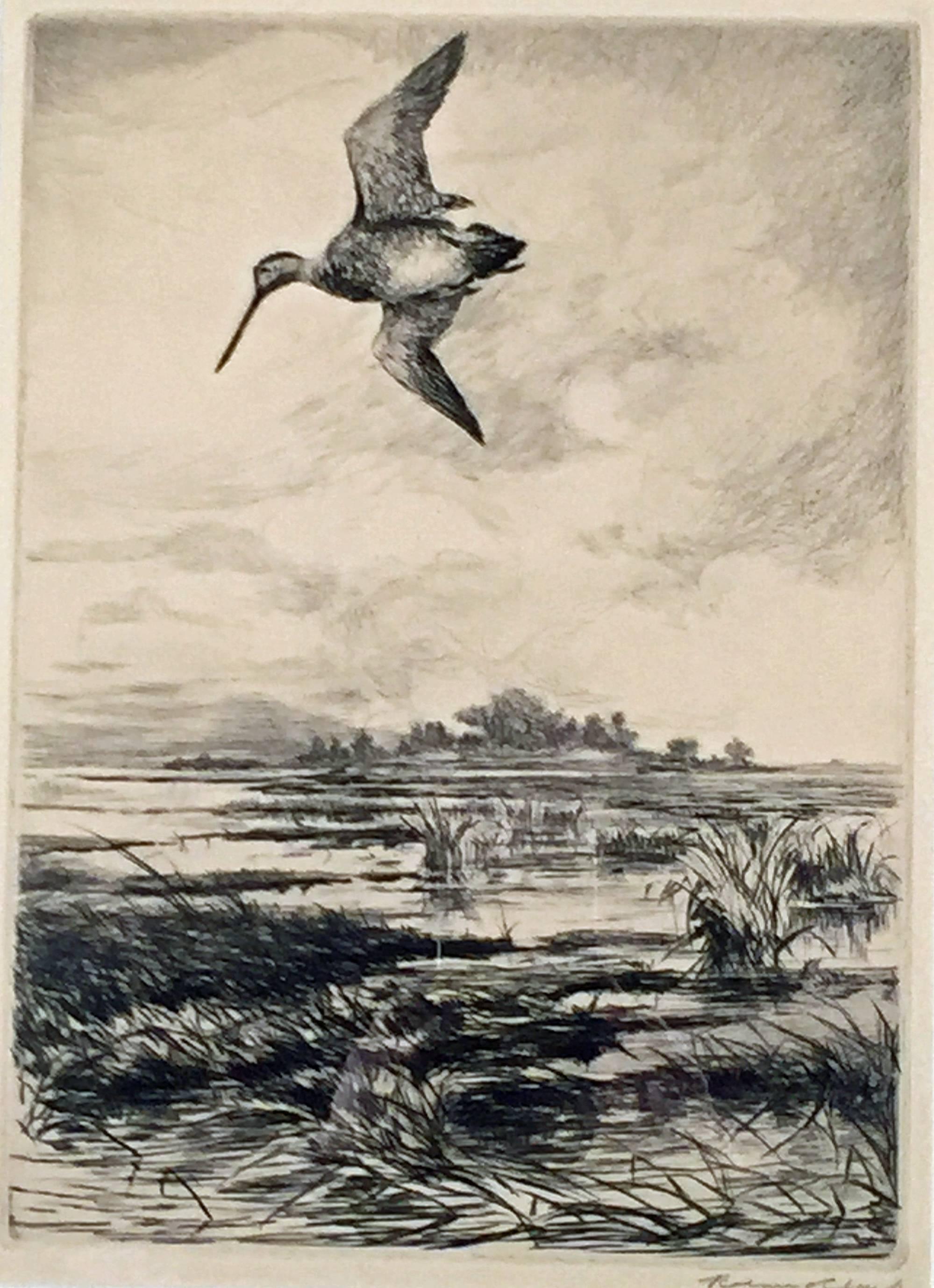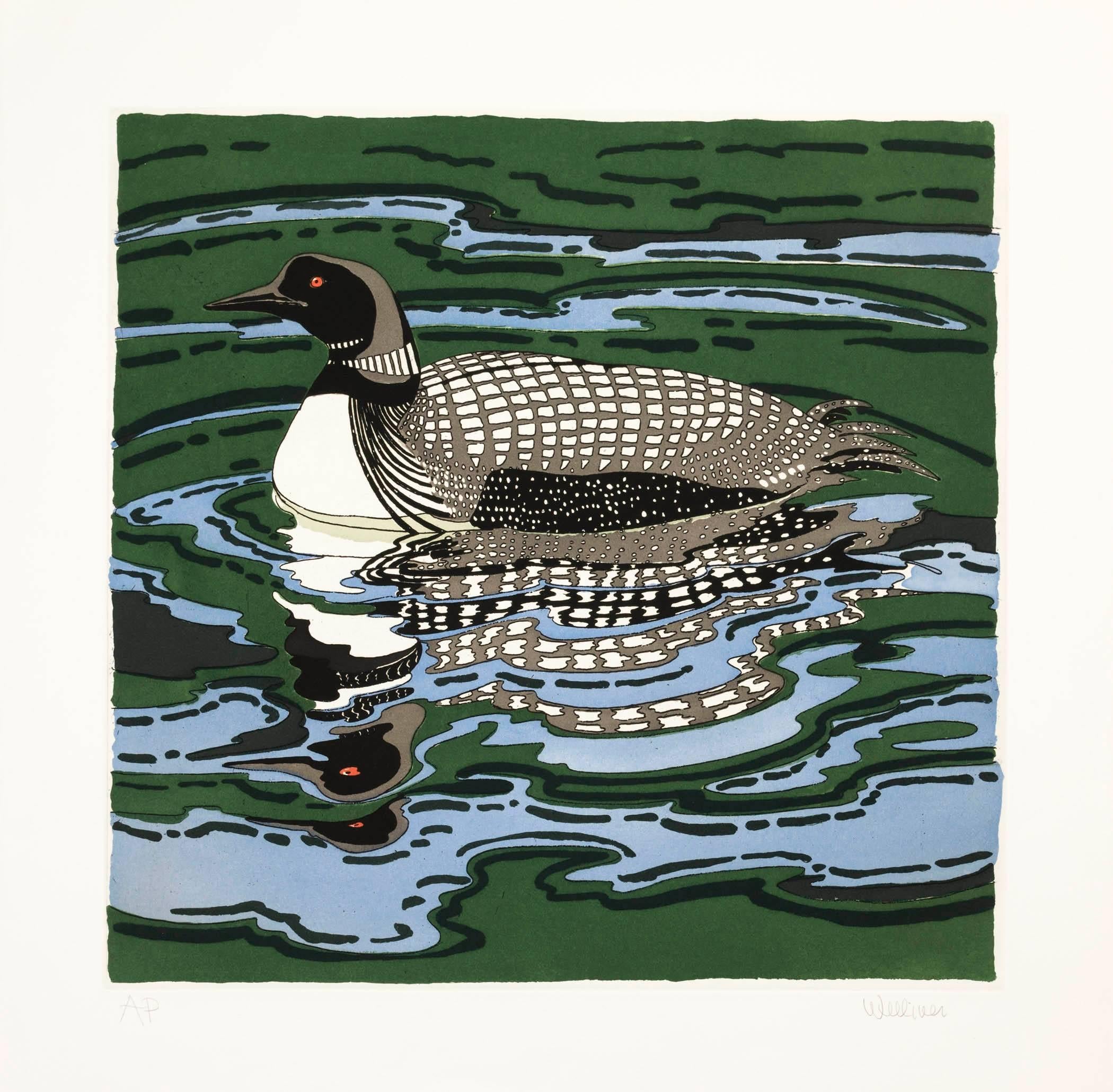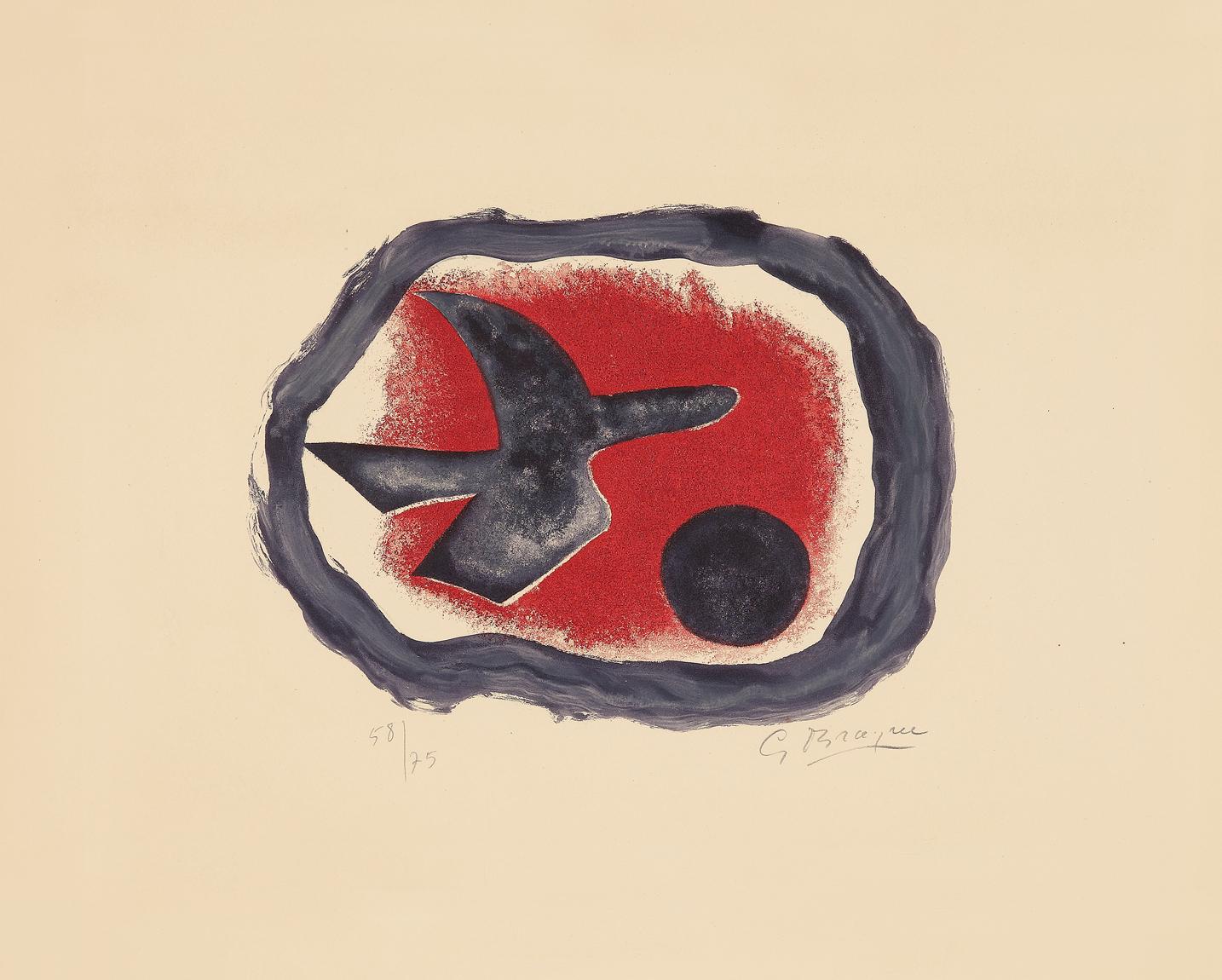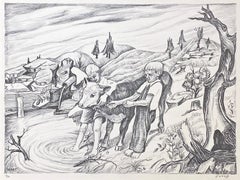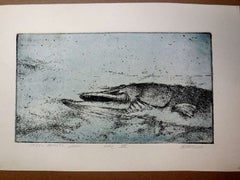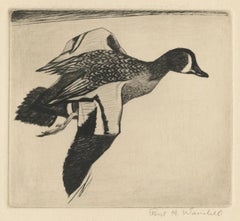
Three English Setters
View Similar Items
Want more images or videos?
Request additional images or videos from the seller
1 of 6
Leon DanchinThree English Settersc. 1940
c. 1940
About the Item
- Creator:Leon Danchin (1887 - 1938, French)
- Creation Year:c. 1940
- Dimensions:Height: 29.5 in (74.93 cm)Width: 37 in (93.98 cm)
- Medium:
- Movement & Style:
- Period:
- Condition:
- Gallery Location:Missouri, MO
- Reference Number:1stDibs: LU74732572223
About the Seller
5.0
Vetted Seller
These experienced sellers undergo a comprehensive evaluation by our team of in-house experts.
Established in 1970
1stDibs seller since 2017
141 sales on 1stDibs
Typical response time: 23 hours
More From This SellerView All
- One of Their Pets (Two Farm Boys and Cow at the Watering Hole)By Joseph VorstLocated in Missouri, MOOne of Their Pets (Two Farm Boys and Cow at The Watering Hole) By Joseph Vorst (1897-1947) Signed Lower Right Edition 1/50 Lower Left Unframed: 8.5" x 11" Framed: 16" x 18.5" German-born Joseph Vorst came from Essen (born June 19, 1897). His teacher was the leading German impressionist Max Liebermann (1847-1935), who was the champion of French impressionism in Berlin. He had traveled to Barbizon and Paris to see paintings by Manet first hand, including In the Conservatory, which made its way to Berlin. Later Vorst's home town of Essen would acquire a collection of modern art in 1921, which became the Museum Folkwang, one of the earliest of its kind. Most likely to escape the Nazis, Vorst made his way to Missouri; we know that he was a member of the American Artists Congress and he signed the famous "Call" in 1936 at the group's first congress, the left-wing organization that stood up to combat fascism. Surely he would have known Joe Jones...Category
Early 20th Century American Realist Landscape Prints
MaterialsLithograph
- American Eagle (Nest Builder III)By Ted BlaylockLocated in Missouri, MOTed Blaylock (b. 1946) "Nest Builder III" 1986 Print Ed. 586/950 Signed and Numbered Ted Blaylock opened his own art studio and gallery in Collinsville, IL in 1969. He eventually mo...Category
1980s American Realist Animal Prints
MaterialsLithograph, Paper
Price Upon Request - Herring GullsBy Jamie WyethLocated in Missouri, MOJamie Wyeth "Herring Gulls" 1978 Color Lithograph Signed Lower Right Numbered Lower Left 149/300 Born in 1946, James Browning Wyeth came of age when the meaning of patriotism was clouded by the traumas of the Vietnam War and the scandals of Watergate. Working in an era of turmoil and questioning of governmental authority, he did art that encompassed both marching off to war and marching in protest. One of James's early masterworks, Draft Age (1965) depicts a childhood friend as a defiant Vietnam-era teenager resplendent in dark sunglasses and black leather jacket in a suitably insouciant pose. Two years later Wyeth painstakingly composed a haunting, posthumous Portrait of President John F. Kennedy (1967) that seems to catch the martyred Chief Executive in a moment of agonized indecision. As Wyeth Center curator Lauren Raye Smith points out, Wyeth "did not deify the slain president, [but] on the contrary made him seem almost too human." Based on hours of study and sketching of JFK's brothers Robert and Edward - documented by insightful studies in the exhibition - the final, pensive portrait seemed too realistic to family members and friends. "His brother Robert," writes Smith in the exhibition catalogue, "reportedly felt uneasy about this depiction, and said it reminded him of the President during the Bay of Pigs invasion." In spite of these misgivings, James's JFK likeness has been reproduced frequently and is one of the highlights of this show. The poignancy, appeal and perceptiveness of this portrait, painted when the youngest Wyeth was 21 years old, makes one wish he would do more portraits of important public figures. James himself feels he is at his best painting people he knows well, as exemplified by his vibrant Portrait of Jean Kennedy Smith (1972), which captures the vitality of the slain President's handsome sister. He did paint a portrait of Jimmy Carter for the January 1977 man-of-the-year cover of Time magazine, showing the casually dressed President-elect as a straightforward character posed under a flag-draped water tower next to the family peanut plant in Plains, Ga. James recalls that Carter had one Secret Service agent guarding him as he posed outdoors, a far cry from the protection our Chief Executives require today. As a participating artist in the "Eyewitness to Space" program organized by the National Aeronautics and Space Administration in collaboration with the National Gallery of Art in the late 1960s, Wyeth deftly recorded in a series of watercolors his eyewitness observations of dramatic spacecraft launchings and more mundane scenes associated with the space program. Commissioned by Harper's Magazine to cover the 1974 congressional hearings and trials of Watergate figures, James Wyeth executed a series of perceptive and now evocative sketches that recall those dark chapters in our history. Memorable images include a scowling John Ehrlichman, a hollow-eyed Bob Haldeman, an owlish Charles Colson, a focused Congressman Peter Rodino, a grim visaged Father/ Congressman Robert Drinan, and vignettes of the press and various courtroom activities. An 11-by-14-inch pencil sketch of the unflappable Judge John Sirica is especially well done. These "images are powerful as historical records," observes Smith, "and as lyrically journalistic impressions of events that changed the nation forever." Wyeth's sketch of early-morning crowds lined up outside the Supreme Court building hoping to hear the Watergate case, with the ubiquitous TV cameramen looking on, is reminiscent of recent scenes as the high court grappled with the Bush-Gore contest. The Wyeth family penchant for whimsy and enigmatic images is evident in Islanders (1990), showing two of James's friends, wearing goofy hats, sitting on the porch of a small Monhegan Island (Me.) cottage draped with a large American flag. Mixing the serious symbolism of Old Glory with the irreverent appearance of the two men, James has created a puzzling but interesting composition. Painting White House...Category
1970s American Modern Animal Prints
MaterialsPaper, Lithograph
Price Upon Request - Nasiterna BruijniBy John GouldLocated in Missouri, MOJohn Gould (British, 1804-1881) Nasiterna Bruijni c. 1849-1861 Hand Colored Lithograph Image Size: approx 19.5 x 13.5 inches Framed Size: 27 3/8 x 21 1/2 inches John Gould was an English ornithologist and bird artist. The Gould League in Australia was named after him. His identification of the birds now nicknamed "Darwin's finches" played a role in the inception of Darwin's theory of evolution by natural selection. Gould's work is referenced in Charles Darwin's book, On the Origin of Species. Gould was born in Lyme Regis, Dorset, the son of a gardener, and the boy probably had a scanty education. Shortly afterwards his father obtained a position on an estate near Guildford, Surrey, and then in 1818 became foreman in the Royal Gardens of Windsor. He was for some time under the care of J T Aiton, of the Royal Gardens of Windsor. The young Gould started training as a gardener, being employed under his father at Windsor from 1818 to 1824, and he was subsequently a gardener at Ripley Castle in Yorkshire. He became an expert in the art of taxidermy, and in 1824 he set himself up in business in London as a taxidermist, and his skill led to him becoming the first Curator and Preserver at the museum of the Zoological Society of London in 1827. Gould's position brought him into contact with the country's leading naturalists, and also meant that he was often the first to see new collections of birds given to the Society. In 1830 a collection of birds arrived from the Himalayas, many not previously described. Gould published these birds in A Century of Birds from the Himalaya Mountains (1830-1832). The text was by Nicholas Aylward Vigors, and the illustrations were lithographed by Gould's wife Elizabeth, daughter of Nicholas Coxen of Kent. This work was followed by four more in the next seven years including Birds of Europe in five volumes - completed in 1837, with the text written by Gould himself, edited by his clerk Edwin Prince. Some of the illustrations were made by Edward Lear as part of his Illustrations of the Family of Psittacidae in 1832. Lear however was in financial difficulty, and he sold the entire set of lithographs to Gould. The books were published in a very large size, imperial folio, with magnificent coloured plates. Eventually 41 of these volumes were published with about 3000 plates. They appeared in parts at £3 3s. a number, subscribed for in advance, and in spite of the heavy expense of preparing the plates, Gould succeeded in making his ventures pay and in realizing a fortune. In 1838 he and his wife moved to Australia to work on the Birds of Australia and shortly after his return to England, his wife died in 1841. When Charles Darwin presented his mammal and bird specimens collected during the second voyage of HMS Beagle to the Geological Society of London at their meeting on 4 January 1837, the bird specimens were given to Gould for identification. He set aside his paying work and at the next meeting on 10 January reported that birds from the Galápagos Islands, which Darwin had thought were blackbirds, "gross-bills" and finches were in fact "a series of ground Finches which are so peculiar" as to form "an entirely new group, containing 12 species." This story made the newspapers. In March, Darwin met Gould again, learning that his Galápagos "wren" was another species of finch and the mockingbirds he had labeled by island were separate species rather than just varieties, with relatives on the South American mainland. Subsequently Gould advised that the smaller southern Rhea specimen that had been rescued from a Christmas dinner...Category
1850s Naturalistic Animal Prints
MaterialsLithograph
- Nasiterna PygmaeBy John GouldLocated in Missouri, MOJohn Gould (British, 1804-1881) Nasiterna Pygmae c. 1849-1861 Hand Colored Lithograph Image Size: approx 19.5 x 13.5 inches Framed Size: 27 3/8 x 21 1/2 inches John Gould was an English ornithologist and bird artist. The Gould League in Australia was named after him. His identification of the birds now nicknamed "Darwin's finches" played a role in the inception of Darwin's theory of evolution by natural selection. Gould's work is referenced in Charles Darwin's book, On the Origin of Species. Gould was born in Lyme Regis, Dorset, the son of a gardener, and the boy probably had a scanty education. Shortly afterwards his father obtained a position on an estate near Guildford, Surrey, and then in 1818 became foreman in the Royal Gardens of Windsor. He was for some time under the care of J T Aiton, of the Royal Gardens of Windsor. The young Gould started training as a gardener, being employed under his father at Windsor from 1818 to 1824, and he was subsequently a gardener at Ripley Castle in Yorkshire. He became an expert in the art of taxidermy, and in 1824 he set himself up in business in London as a taxidermist, and his skill led to him becoming the first Curator and Preserver at the museum of the Zoological Society of London in 1827. Gould's position brought him into contact with the country's leading naturalists, and also meant that he was often the first to see new collections of birds given to the Society. In 1830 a collection of birds arrived from the Himalayas, many not previously described. Gould published these birds in A Century of Birds from the Himalaya Mountains (1830-1832). The text was by Nicholas Aylward Vigors, and the illustrations were lithographed by Gould's wife Elizabeth, daughter of Nicholas Coxen of Kent. This work was followed by four more in the next seven years including Birds of Europe in five volumes - completed in 1837, with the text written by Gould himself, edited by his clerk Edwin Prince. Some of the illustrations were made by Edward Lear as part of his Illustrations of the Family of Psittacidae in 1832. Lear however was in financial difficulty, and he sold the entire set of lithographs to Gould. The books were published in a very large size, imperial folio, with magnificent coloured plates. Eventually 41 of these volumes were published with about 3000 plates. They appeared in parts at £3 3s. a number, subscribed for in advance, and in spite of the heavy expense of preparing the plates, Gould succeeded in making his ventures pay and in realizing a fortune. In 1838 he and his wife moved to Australia to work on the Birds of Australia and shortly after his return to England, his wife died in 1841. When Charles Darwin presented his mammal and bird specimens collected during the second voyage of HMS Beagle to the Geological Society of London at their meeting on 4 January 1837, the bird specimens were given to Gould for identification. He set aside his paying work and at the next meeting on 10 January reported that birds from the Galápagos Islands, which Darwin had thought were blackbirds, "gross-bills" and finches were in fact "a series of ground Finches which are so peculiar" as to form "an entirely new group, containing 12 species." This story made the newspapers. In March, Darwin met Gould again, learning that his Galápagos "wren" was another species of finch and the mockingbirds he had labeled by island were separate species rather than just varieties, with relatives on the South American mainland. Subsequently Gould advised that the smaller southern Rhea specimen that had been rescued from a Christmas dinner...Category
Mid-19th Century Naturalistic Animal Prints
MaterialsLithograph
- Bird's Eye ViewBy Ronnie CutroneLocated in Missouri, MORonnie Cutrone (1948-2013) "Bird's Eye View" c. 1980s Color Lithograph Ed. 222/250 Signed, Numbered and Titled Image Size: 17 x 23.5 inches Framed Size: approx. 24 x 30 inches. Ronnie Cutrone, a figurehead of the Pop and Post-Pop art scenes, was Andy Warhol's assistant at the Factory atop the Decker Building from 1972-1980, and worked closely with Roy Lichtenstein, combining stylistic elements of both. Cutrone's large-scale paintings of American cartoon icons, like Mickey Mouse, Felix the Cat, and Woody Woodpecker further reinvented kitsch and popular media in terms of fine art. Executed in fluorescent monochromatic colors with the finesse of mass-produced silkscreen and prints, Cutrone's works are the reverse of tromp-l'oeil; they use fine art media (watercolor, pastel, crayon - on high-quality paper) to celebrate, rather than hide, the artifice of their subjects. "Everything is cartoon for me", Cutrone is noted for saying, even "ancient manuscripts...Category
Late 20th Century Pop Art Figurative Prints
MaterialsLithograph
Price Upon Request
You May Also Like
- Pike IIIBy Robert A. BirmelinLocated in Surfside, FLA fine etching of a Pike Fish. Perfect for the angler or sport fisherman Born in Newark, New Jersey, Robert Birmelin became a professor of fine arts at Queens College in New York, an...Category
20th Century American Realist Animal Prints
MaterialsEtching
- THREE'S A CROWDBy Marguerite KirmseLocated in Santa Monica, CAMARGUERITE KIRMSE (English/American 1885-1954) THREE’S A CROWD, c 1930 Etching, signed and titled in pencil. Plate 6 3/8 x 9 ¾ inches. Full sheet with edges on all sides. Sheet 10 5/8 x 13 5/8 inches. In good condition, save for old tape on sheet edges verso, showing through to recto. A hint of a mat line below the signature Kirmse is considered to be one of the most important etchers of Dogs. Sheet with even white tone - photos show oblique shadows From Wikipedia: Marguerite first trained as a harpist at the Royal Academy of Music but spent much of her spare time drawing animals. She went to the United States in 1910 on holiday with friends but stayed there.[4] She was not successful in advancing her musical career and focused her attention increasingly on her animal drawing, which she developed by frequent sketching trips to the Bronx Zoo.[5] In 1921 she started producing etchings of dogs...Category
1930s American Realist Animal Prints
MaterialsEtching
$506 Sale Price25% Off - Blue WingBy Paul H. WinchellLocated in Fairlawn, OHBlue Wing Etching, c. 1940 Signed in the lower right (see photo) Created while the artist was a commercial artist working in Minneapolis, after his tenure o...Category
1940s American Realist Animal Prints
MaterialsEtching
- A Burro Train, New MexicoBy Peter MoranLocated in Middletown, NYEtching with aquatint on heavy laid paper, 7 x 9 1/4 inches (172 x 233 mm), full margins. Signed in the plate, lower right image area. Minor corner loss, top right, and a 1/4 inch ed...Category
Late 19th Century American Realist Animal Prints
MaterialsLaid Paper, Etching
- Black Ducks (Marsh Ducks)Located in Fairlawn, OHBlack Ducks (Marsh Ducks) Etching, 1964 Signed in pencil lower right Titled in pencil lower left Edition: 250 Published by Associated American Artist, New York Illustrated: AAA catal...Category
1960s American Realist Animal Prints
MaterialsEtching
- Drawn from the Heart ( 1, 2&3 )By Bev DoolittleLocated in Austin, TX"Drawn from the Heart" by Bev Doolittle Set of Three Signed Limited Edition Original Etching on PaperCategory
1990s American Realist Animal Prints
MaterialsEtching
Recently Viewed
View AllMore Ways To Browse
English Setter
English Sporting Dogs Paintings
English Setter Art
Painting English Setter
English Setter Vintage
Blue Dog Original Prints
Signed Prints Rodrigue
Antique Prison Art
Engravings Hunting
Hunting Engravings
George Rodrigue Signed Print
George Rodrigue Blue Dog Signed
Blue Dog And Rodrigues
J Clark Paintings
John J Audubon
Lewis Clark
Large Tropical Prints
Vintage Audubon Prints


